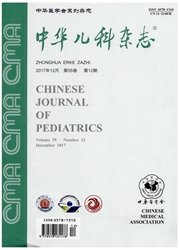

 中文摘要:
中文摘要:
目的评估高胆红素血症对新生儿自发性眨眼的影响。方法采用新生儿行为神经(NBNA)评分法、5分钟眨眼试验,检测评估53例高胆红素血症新生儿,按小时胆红素值分为高胆1组(〉小时胆红素第75百分位值)和高胆2纽(〉小时胆红素第95百分位值),在黄疸消退后重复上述两项测评,并与38例同日龄正常新生儿对照。结果(1)高胆红索血症新生儿NBNA评分明显低于正常同日龄新生儿,且自发性眨眼明显增多,差异有统计学意义(P〈0.05)。(2)高胆红素血症新生儿在黄疸消退后,NBNA评分和自发性眨眼频率较黄疸高峰期有所恢复,结果差异有统计学意义(P〈0.01)。(3)黄疸消退后高胆1组与同日龄的正常新生儿比较,NBNA评分和5分钟自发性眨眼频率差异无统计学意义(P值均〉0.05)。而高胆2组NBNA总分包括原始反射、一般评估仍明显低于正常同龄新生儿(P〈0.01);自发性眨眼频率仍较同日龄新生儿增多(P〈0.05)。(4)黄疸消退后高胆1组的NBNA评分、自发性眨眼恢复较好,与高胆2组比较差异有统计学意义(P〈0.05)。结论高胆红素血症可影响新生儿的行为表现和自发性眨眼频率,其影响程度与黄疸严重度有关。
 英文摘要:
英文摘要:
Objective To evaluate the influence of hyperbilirubinemia on spontaneous eye - blinking in newborns. Methods Fifty -throe hyperbilirnbinemia newborns and thirty- eight normal newborns at the same age were examined by the NBNA score and 5 minutes eye-blinking test. The hyperbilirubinemia newborns were divided into two groups, hyperbilirubinemia I (including 33 cases: serum bilirubin 〉 75th percentile) and hyperbilirnbinemia I1 (including 20 cases: serum bilirnbin 〉 95th percentile). After the fade away of jaundice, tests were repeated, and results of hyperbilirubinemia newborns were compared with those of normal newborns. Results ( 1 ) NBNA score of hyperbilirubinemia newborns was lower and the eye - blinking times was more than that of normal newborns. The differences between them were statistically significant. (2) After the fade away of jaundice, the NBNA score and 5 minutes eye -blinking test improved significantly( P〈0. 01 ). (3) After the fade away of jaundice, there were no significant differences of the NBNA score and 5 minutes eye - blinking test between the hyperbilirubinemia I and the normal newborns ( P〉 0. 05 ) , but the NBNA score including the primary reflex and general assessment in the hyperbilirnbinemia Ⅱ was still obviously lower than that in the normal newborns( P〈0. 01 ). The spontaneous eye - blinking frequency was much higher than that in the normal newborns ( P〈 0. 05 ). (4) After the fade away of jaundice, the NBNA score and 5 minutes eye - blinking test in the hyperbilirubinemia I recovered better than those in hyperbilirubinemia Ⅱ with a significant difference ( P 〈 0. 05). Conclusions Hyperbilirubinemia can influence behavioral expression and spontaneous eye-blinking frequency in newborns and its severity has some relationships with that of jaundice. It can be inferred that neurotoxicity of bilirubin may induce some dopamine sub - systems more active and sensitive, and rosuh in the behavioral changes of newborns.
 同期刊论文项目
同期刊论文项目
 同项目期刊论文
同项目期刊论文
 期刊信息
期刊信息
